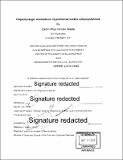| dc.contributor.advisor | Kay M. Tye. | en_US |
| dc.contributor.author | Vander Weele, Caitlin Miya | en_US |
| dc.contributor.other | Massachusetts Institute of Technology. Department of Brain and Cognitive Sciences. | en_US |
| dc.date.accessioned | 2019-03-01T19:53:10Z | |
| dc.date.available | 2019-03-01T19:53:10Z | |
| dc.date.copyright | 2018 | en_US |
| dc.date.issued | 2018 | en_US |
| dc.identifier.uri | http://hdl.handle.net/1721.1/120628 | |
| dc.description | Thesis: Ph. D. in Neuroscience, Massachusetts Institute of Technology, Department of Brain and Cognitive Sciences, 2018. | en_US |
| dc.description | Cataloged from PDF version of thesis. Page 176 blank. | en_US |
| dc.description | Includes bibliographical references (pages 159-175). | en_US |
| dc.description.abstract | Despite abundant evidence that dopamine modulates medial prefrontal cortex (mPFC) activity to mediate diverse behavioral functions, the precise circuit computations remain elusive. One potentially unifying theoretical model by which dopamine can modulate functions from working memory to schizophrenia is that dopamine serves to increase the signal-to-noise ratio in mPFC neurons, where neuronal activity conveying sensory information (signal) are amplified relative to spontaneous firing (noise). To connect theory to biology, we lack direct evidence for dopaminergic modulation of signal-to-noise in neuronal firing patterns in vivo and a mechanistic explanation of how such computations would be transmitted downstream to instruct specific behavioral functions. Here, we demonstrate that dopamine increases signal-to-noise ratio in mPFC neurons projecting to the dorsal periaqueductal gray (dPAG) during the processing of an aversive stimulus. First, using electrochemical approaches, we reveal the precise time course of tail pinch-evoked dopamine release in the mPFC. Second, we show that dopamine signaling in the mPFC biases behavioral responses to punishment-predictive stimuli, rather than reward-predictive cues. Third, in contrast to the well-characterized mPFC-NAc projection, we show that activation of mPFC-dPAG neurons is sufficient to drive place avoidance and defensive behaviors. Fourth, to determine the natural dynamics of individual mPFC neurons, we performed single-cell projection-defined microendoscopic calcium imaging to reveal a robust preferential excitation of mPFC-dPAG, but not mPFC-NAc, neurons to aversive stimuli. Finally, photostimulation of VTA dopamine terminals in the mPFC revealed an increase in signal-to-noise ratio in mPFC-dPAG neuronal activity during the processing of aversive, but not rewarding stimuli. Together, these data unveil the utility of dopamine in the mPFC to effectively filter sensory information in a valence-specific manner. | en_US |
| dc.description.statementofresponsibility | by Caitlin Miya Vander Weele. | en_US |
| dc.format.extent | 176 pages | en_US |
| dc.language.iso | eng | en_US |
| dc.publisher | Massachusetts Institute of Technology | en_US |
| dc.rights | MIT theses are protected by copyright. They may be viewed, downloaded, or printed from this source but further reproduction or distribution in any format is prohibited without written permission. | en_US |
| dc.rights.uri | http://dspace.mit.edu/handle/1721.1/7582 | en_US |
| dc.subject | Brain and Cognitive Sciences. | en_US |
| dc.title | Dopaminergic modulation of prefrontal cortex subpopulations | en_US |
| dc.type | Thesis | en_US |
| dc.description.degree | Ph. D. in Neuroscience | en_US |
| dc.contributor.department | Massachusetts Institute of Technology. Department of Brain and Cognitive Sciences | |
| dc.identifier.oclc | 1086611189 | en_US |
